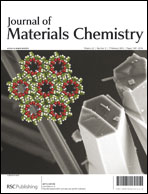We investigated phase-controllable copper oxide (CuOx) as a hole injection layer for improving the electrical and optical properties of organic light emitting diodes (OLEDs). The phase of CuOx is changed from CuO to Cu2O by elevating the deposition rate during thermal evaporation, and a non-stoichiometric film mixing with two phases occurs in the intermediate condition. In non-stoichiometric films, unbonded oxygen atoms with a large density of gap states are induced near the Fermi level, acting as a hole transport path. Thus, holes can be more easily injected into the highest occupied molecular orbital states of α-NPD, lowering the hole injection barrier significantly. Films of non-stoichiometric CuOx are inserted at the interface of α-NPD with an Ag electrode, serving as the hole injection layer. Significantly improved current densities and luminance were achieved, reducing the operation voltage at 1 mA cm−2 from 6.1 V to 3.2 V.
You have access to this article
 Please wait while we load your content...
Something went wrong. Try again?
Please wait while we load your content...
Something went wrong. Try again?


 Please wait while we load your content...
Please wait while we load your content...